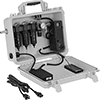Filter by
Display Type
Input Voltage
Counting Direction
Wire Connection
Operating Voltage
Input Method
Maximum Counts per Minute
Environment
Output Relay Current @ Input Voltage
Overall Width
Minimum Temperature
Maximum Temperature
Export Control Classification Number (ECCN)
Certification
DFARS Specialty Metals
Measuring and Inspecting

Hour Meters
Display running time on a machine so you can schedule preventative maintenance
20 products
Fluid Handling
Facility and Grounds Maintenance
Safety Equipment









































